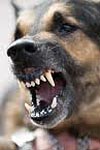
Spotting Aggressive Facial Language
A friendly dog has a relaxed facial expression, and its eyes appear to be a normal size. If a dog stares at you directly with a tense facial expression, it’s a sign of aggression. React by looking away slowly; this is how another dog would show submission, and it may help calm your aggressor. If the dog’s eyes appear small, or it looks away from you submissively, it may be frightened. Don’t assume this is an opportunity to approach the dog. A frightened dog may attack if it feels cornered or intimidated.
Retracted lips that expose the dog’s teeth are another clear sign of aggressive intent. If the dog pulls its lips up and wrinkles the top of its muzzle to show its front teeth, it’s telling you not to come closer. When a dog is preparing to bite, its lips will be up and back and its mouth open to expose all teeth. A wrinkled forehead, lips that look large or puffy, and heavy breathing also indicate intent to attack.
Aggressive Canine Body Language
A dominant, aggressive dog tries to make itself look as large as possible. It will tense its muscles, stand upright and straight, and lean slightly forward in preparation to lunge. The rigid, still stance may be accompanied by warning lunges in which the dog doesn’t actually make physical contact. You may also notice that the hair along its neck or back stands up. Its tail may be erect and wagging. Obvious signs of aggression include growling, barking, lunging, biting, and circling or pacing. Some aggressive dogs also punch a person with their muzzle, or give a quick warning nip without causing injury. When you’re confronted with aggressive behaviors, back away slowly without looking directly into the dog’s eyes. Don’t run or make any sudden or sharp movements or noises; this can provoke an attack. Move out of the dog’s range if possible, and contact animal control immediately.
Understanding Dog Behavior Isn’t Always Enough
Unfortunately, even when you’re armed with knowledge, it may not always be possible to avoid a dog attack. Violent animals are unpredictable, and some confrontations are more volatile than others. If you or a loved one is injured despite efforts to stay safe, the law offices of Jeffrey Harlan Penneys, Esq. is here to help. Our expertise can help you get the compensation you rightfully deserve for medical expenses, lost wages, and other damages. Simply fill out our convenient online contact form, and we’ll respond within 24 hours. Call 215-987-3550 (office) or 215-771-0430 (cell) today.